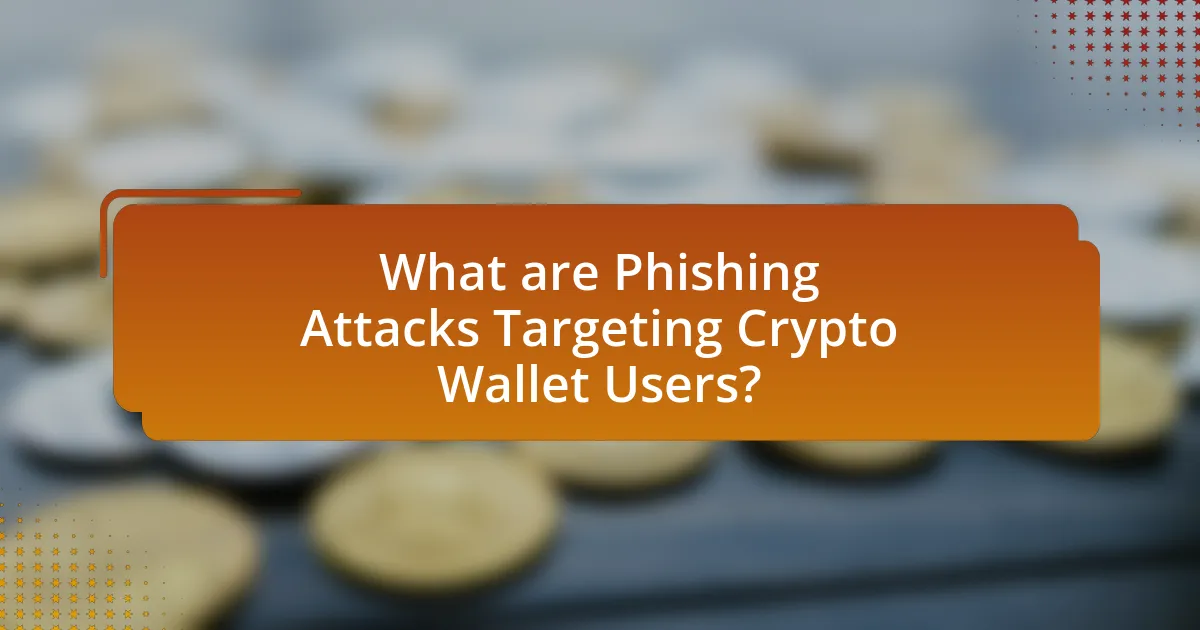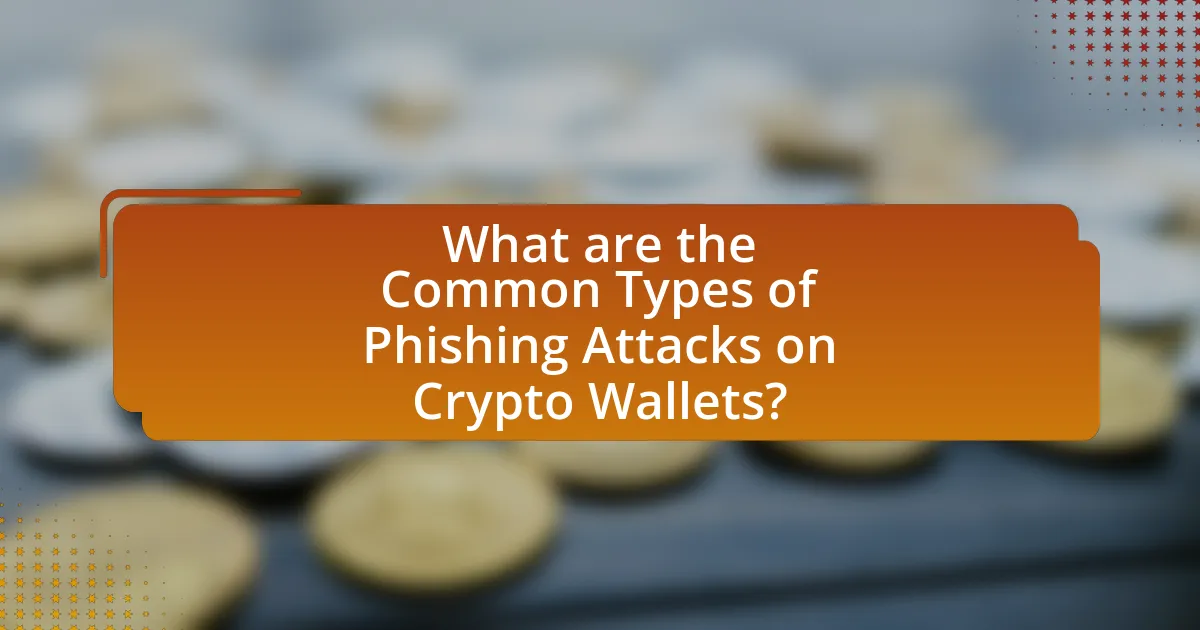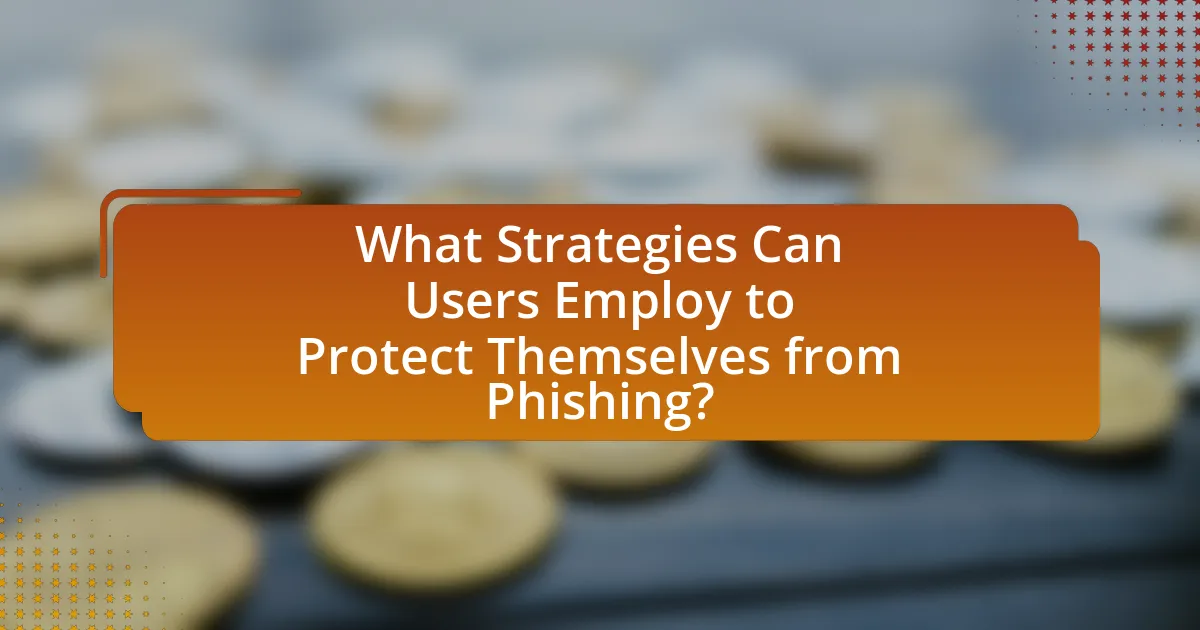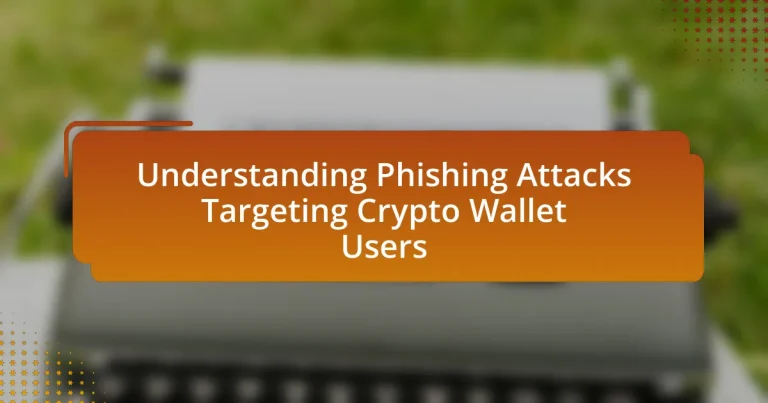Phishing attacks targeting crypto wallet users are fraudulent schemes aimed at deceiving individuals into disclosing sensitive information, such as private keys and login credentials, by mimicking legitimate services. These attacks have surged significantly, with reports indicating over 1,000 incidents in 2021 alone, highlighting the urgent need for awareness among users. The article explores various techniques employed by attackers, including email spoofing and social engineering, and discusses the psychological tactics that exploit user vulnerabilities. It emphasizes the importance of understanding these threats and outlines effective strategies for users to protect themselves, including verifying communications, enabling two-factor authentication, and staying informed about the latest phishing trends.

What are Phishing Attacks Targeting Crypto Wallet Users?
Phishing attacks targeting crypto wallet users are fraudulent schemes designed to deceive individuals into revealing sensitive information, such as private keys or login credentials, by impersonating legitimate services. These attacks often utilize fake websites or emails that closely resemble those of reputable cryptocurrency platforms, tricking users into entering their personal data. According to a report by the Anti-Phishing Working Group, there was a significant increase in phishing attacks related to cryptocurrency, with over 1,000 incidents reported in 2021 alone, highlighting the growing threat to crypto wallet users.
How do phishing attacks specifically target crypto wallet users?
Phishing attacks specifically target crypto wallet users by impersonating legitimate services to steal sensitive information such as private keys and recovery phrases. Attackers often create fake websites or send fraudulent emails that appear to be from well-known cryptocurrency exchanges or wallet providers, tricking users into entering their credentials. According to a report by the Anti-Phishing Working Group, the number of phishing attacks targeting cryptocurrency users increased by over 200% in 2021, highlighting the growing threat. These tactics exploit the lack of awareness among users regarding security practices, making them vulnerable to such scams.
What techniques do attackers use in phishing schemes?
Attackers use various techniques in phishing schemes, including email spoofing, social engineering, and malicious links. Email spoofing involves forging the sender’s address to appear legitimate, tricking users into trusting the communication. Social engineering exploits human psychology, often creating a sense of urgency or fear to prompt immediate action. Malicious links direct victims to fraudulent websites designed to capture sensitive information, such as login credentials or financial details. According to the Anti-Phishing Working Group, there were over 200,000 unique phishing attacks reported in a single month in 2021, highlighting the prevalence and effectiveness of these techniques.
How do these techniques exploit user vulnerabilities?
Phishing techniques exploit user vulnerabilities by manipulating psychological factors such as trust and urgency. Attackers often create fake websites or emails that closely resemble legitimate services, tricking users into providing sensitive information like passwords or private keys. For instance, a study by the Anti-Phishing Working Group reported that in 2020, over 75% of phishing attacks targeted financial services, indicating a high success rate in exploiting users’ trust in recognizable brands. This manipulation of user psychology, combined with the urgency often conveyed in phishing messages, leads to a significant increase in the likelihood of users falling victim to these attacks.
Why is understanding phishing attacks important for crypto wallet users?
Understanding phishing attacks is crucial for crypto wallet users because these attacks are a primary method used by cybercriminals to steal sensitive information and funds. Phishing schemes often involve deceptive emails or websites that mimic legitimate services, tricking users into providing their private keys or login credentials. According to a report by the Anti-Phishing Working Group, there were over 200,000 unique phishing attacks reported in the first quarter of 2021 alone, highlighting the prevalence of this threat. By recognizing the tactics used in phishing attacks, crypto wallet users can better protect their assets and avoid falling victim to scams.
What are the potential consequences of falling victim to phishing?
Falling victim to phishing can lead to significant financial loss and identity theft. Phishing attacks often result in unauthorized access to sensitive information, such as passwords and private keys, which can be exploited to drain cryptocurrency wallets. According to a report by the Anti-Phishing Working Group, there were over 200,000 phishing attacks reported in the first quarter of 2021 alone, highlighting the prevalence and potential impact of such attacks. Additionally, victims may face long-term consequences, including damage to their credit score and the emotional distress associated with financial fraud.
How can awareness of phishing attacks enhance user security?
Awareness of phishing attacks enhances user security by enabling individuals to recognize and avoid deceptive tactics used by cybercriminals. When users understand the common signs of phishing, such as suspicious emails or misleading links, they are less likely to fall victim to these scams. Research indicates that organizations with regular phishing awareness training see a 70% reduction in successful phishing attacks, demonstrating the effectiveness of education in improving security. By fostering a culture of vigilance, users can protect their sensitive information and reduce the risk of unauthorized access to their crypto wallets.

What are the Common Types of Phishing Attacks on Crypto Wallets?
Common types of phishing attacks on crypto wallets include email phishing, fake websites, and social media scams. Email phishing involves attackers sending fraudulent emails that appear to be from legitimate sources, tricking users into revealing their private keys or login credentials. Fake websites mimic official wallet sites, leading users to enter sensitive information, which is then captured by the attackers. Social media scams often involve impersonating well-known figures or companies to solicit personal information or prompt users to click on malicious links. According to a report by the Anti-Phishing Working Group, phishing attacks targeting cryptocurrency users have increased significantly, highlighting the prevalence and danger of these tactics.
What are the different forms of phishing attacks targeting crypto wallets?
Different forms of phishing attacks targeting crypto wallets include email phishing, fake websites, social media scams, and SMS phishing (smishing). Email phishing involves sending fraudulent emails that appear to be from legitimate sources, tricking users into revealing their wallet credentials. Fake websites mimic authentic wallet services, capturing sensitive information when users attempt to log in. Social media scams often involve impersonating well-known figures or companies to solicit private keys or personal information. SMS phishing targets users through text messages, prompting them to click on malicious links that lead to phishing sites. These methods exploit the growing interest in cryptocurrencies, making users vulnerable to financial loss.
How do email phishing attacks operate?
Email phishing attacks operate by tricking individuals into revealing sensitive information, such as passwords or financial details, through deceptive emails that appear to be from legitimate sources. Attackers often craft messages that mimic trusted entities, prompting recipients to click on malicious links or download harmful attachments. According to the Anti-Phishing Working Group, in 2021, there were over 200,000 reported phishing attacks, highlighting the prevalence of this tactic. These attacks exploit social engineering techniques, creating a sense of urgency or fear to manipulate victims into acting quickly without verifying the source.
What role do fake websites play in phishing schemes?
Fake websites serve as critical tools in phishing schemes by mimicking legitimate sites to deceive users into providing sensitive information. These fraudulent sites often replicate the design and functionality of authentic platforms, such as cryptocurrency wallets, to create a false sense of security. Research indicates that over 90% of phishing attacks involve fake websites, highlighting their prevalence in cybercrime. By tricking users into entering personal data, such as passwords and private keys, these sites facilitate unauthorized access to accounts and financial loss.
How do social engineering tactics contribute to phishing attacks?
Social engineering tactics significantly enhance the effectiveness of phishing attacks by manipulating human psychology to elicit trust and compliance. Phishing attacks often employ techniques such as impersonation, urgency, and emotional appeal to deceive victims into revealing sensitive information, such as passwords or private keys. For instance, a study by the Anti-Phishing Working Group reported that 83% of phishing emails used social engineering tactics to create a sense of urgency, prompting users to act quickly without verifying the source. This manipulation exploits cognitive biases, making individuals more susceptible to fraudulent requests, thereby increasing the likelihood of successful attacks on crypto wallet users.
What psychological tricks do attackers use to deceive users?
Attackers use various psychological tricks to deceive users, primarily leveraging tactics such as urgency, authority, and social proof. For instance, they often create a sense of urgency by claiming that immediate action is required to secure an account or avoid a loss, which can lead users to make hasty decisions without proper scrutiny. Additionally, attackers may impersonate authoritative figures or organizations, exploiting trust to manipulate users into providing sensitive information. Social proof is another tactic, where attackers present fake testimonials or statistics to create an illusion of legitimacy, making users more likely to comply with their requests. These methods are effective because they exploit cognitive biases and emotional responses, leading to increased vulnerability among users.
How can users recognize social engineering tactics?
Users can recognize social engineering tactics by being aware of common signs such as unsolicited communication, urgency, and requests for sensitive information. For instance, attackers often create a sense of urgency to prompt quick responses, which can be identified by phrases like “act now” or “limited time offer.” Additionally, users should be cautious of unsolicited emails or messages that ask for personal details, as legitimate organizations typically do not request sensitive information through these channels. Research from the Cybersecurity & Infrastructure Security Agency indicates that 97% of people cannot identify a phishing email, highlighting the importance of education and vigilance in recognizing these tactics.

What Strategies Can Users Employ to Protect Themselves from Phishing?
Users can protect themselves from phishing by implementing several key strategies. First, they should verify the authenticity of emails and messages by checking the sender’s address and looking for signs of spoofing, such as misspellings or unusual domains. According to the Anti-Phishing Working Group, 75% of phishing attacks involve email, making scrutiny essential.
Second, users should enable two-factor authentication (2FA) on their accounts, which adds an extra layer of security beyond just passwords. Research shows that 2FA can block 99.9% of automated attacks.
Third, users must avoid clicking on links or downloading attachments from unknown sources, as these are common methods for delivering phishing malware. The Federal Trade Commission reports that phishing scams often use urgency or fear to prompt quick actions, so users should take time to assess the situation.
Lastly, users should regularly update their software and security tools to protect against vulnerabilities that phishing attacks may exploit. The Cybersecurity & Infrastructure Security Agency emphasizes that keeping software up to date is a critical defense against cyber threats.
What best practices should crypto wallet users follow to avoid phishing?
Crypto wallet users should implement several best practices to avoid phishing attacks. First, they must verify the authenticity of websites and links before entering sensitive information; this includes checking for HTTPS in the URL and ensuring the domain name is correct. Second, users should enable two-factor authentication (2FA) on their wallets, which adds an extra layer of security by requiring a second form of verification. Third, they should be cautious of unsolicited communications, such as emails or messages that request personal information or prompt users to click on links. Additionally, users should regularly update their wallet software to protect against vulnerabilities. According to the Anti-Phishing Working Group, phishing attacks have increased significantly, with over 200,000 reported incidents in 2020 alone, highlighting the importance of these practices for safeguarding crypto assets.
How can users verify the authenticity of communications?
Users can verify the authenticity of communications by checking the sender’s email address, looking for signs of phishing such as poor grammar or urgent requests, and using official channels to confirm the message. For instance, legitimate organizations will typically use official domain names, and users should cross-reference any communication with the organization’s official website or customer service. Additionally, employing security features like two-factor authentication and verifying digital signatures can further ensure the integrity of the communication. These methods are supported by cybersecurity best practices, which emphasize the importance of vigilance against phishing attacks, particularly in the context of crypto wallet security.
What security measures can be implemented to enhance protection?
Implementing multi-factor authentication (MFA) significantly enhances protection against phishing attacks targeting crypto wallet users. MFA requires users to provide two or more verification factors to gain access, making it more difficult for attackers to compromise accounts. According to a study by Google, MFA can block 99.9% of automated attacks, demonstrating its effectiveness in securing sensitive information. Additionally, educating users about recognizing phishing attempts and using hardware wallets for storing cryptocurrencies further strengthens security measures.
What resources are available for educating users about phishing attacks?
Resources available for educating users about phishing attacks include online training programs, government websites, and cybersecurity organizations. Online training programs, such as those offered by KnowBe4 and Cybrary, provide interactive courses that teach users how to recognize and respond to phishing attempts. Government websites like the Federal Trade Commission (FTC) and the Cybersecurity & Infrastructure Security Agency (CISA) offer comprehensive guides and tips on identifying phishing scams. Additionally, organizations like the Anti-Phishing Working Group (APWG) provide resources and reports that help users stay informed about the latest phishing tactics and trends. These resources are essential for enhancing user awareness and reducing the risk of falling victim to phishing attacks.
How can users stay updated on the latest phishing threats?
Users can stay updated on the latest phishing threats by subscribing to cybersecurity newsletters and following reputable security blogs. These sources often provide timely information about emerging phishing tactics and trends, helping users recognize potential threats. For instance, organizations like the Cybersecurity and Infrastructure Security Agency (CISA) and the Anti-Phishing Working Group (APWG) regularly publish alerts and reports on phishing incidents, which can be invaluable for users seeking to protect their crypto wallets.
What role do community forums and support groups play in user education?
Community forums and support groups play a crucial role in user education by providing a platform for sharing knowledge and experiences related to phishing attacks targeting crypto wallet users. These forums facilitate real-time discussions where users can ask questions, share warnings about potential scams, and disseminate best practices for securing their wallets. Research indicates that peer-to-peer learning in such environments enhances users’ understanding of security threats, as evidenced by a study published in the Journal of Cybersecurity Education, Research and Practice, which found that 78% of participants reported increased awareness of phishing tactics after engaging in community discussions. This collaborative learning approach empowers users to recognize and respond to phishing attempts more effectively, thereby improving their overall security posture.
What are the key takeaways for crypto wallet users to prevent phishing attacks?
To prevent phishing attacks, crypto wallet users should implement several key strategies. First, users must verify the authenticity of websites and emails by checking URLs and sender addresses carefully, as phishing attempts often use deceptive links. Second, enabling two-factor authentication (2FA) adds an extra layer of security, making unauthorized access more difficult. Third, users should avoid sharing sensitive information, such as private keys or recovery phrases, as legitimate services will never request this data. Additionally, keeping software and wallets updated ensures protection against known vulnerabilities. Lastly, educating oneself about common phishing tactics can help users recognize and avoid potential threats. These measures are supported by cybersecurity studies indicating that awareness and proactive security practices significantly reduce the risk of falling victim to phishing attacks.


